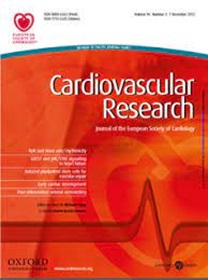心脏淀粉样变性的体外和体内疾病模型:进展、缺陷和潜力
IF 13.3
1区 医学
Q1 CARDIAC & CARDIOVASCULAR SYSTEMS
引用次数: 0
摘要
淀粉样蛋白轻链(AL)和转甲状腺素淀粉样变性(ATTR)引起的心肌病是危及生命的蛋白质错误折叠疾病,其特征是淀粉样蛋白纤维沉积在心脏中,严重损害心功能。缺乏具有代表性的疾病模型阻碍了理解潜在机制的进展,阻碍了特异性生物标志物和有效治疗方法的发现和发展。为了解决这个问题,研究人员开发了各种细胞和动物模型来概括这些疾病。在AL淀粉样变性中,细胞和小鼠模型强调了可溶性轻链(lc)和lc衍生的淀粉样原纤维的毒性作用,如溶酶体功能障碍、内质网应激和氧化应激。转基因小鼠模型,特别是那些没有小鼠重链和添加淀粉样蛋白种子的小鼠模型,已经成功地复制了系统性AL淀粉样变性,对心脏有明显的影响。对于ATTR淀粉样变性,在二维细胞模型中,酸诱导的转甲状腺素(TTR)原纤维可诱导细胞功能障碍,如细胞内ROS水平升高、肌节紊乱和钙处理时间延长。表达人类WT或变异TTR的转基因小鼠模型为淀粉样心肌病的发展提供了见解,但要完全复制人类表型仍然存在挑战。本文综述了用于研究AL和ATTR淀粉样变引起的心肌病的各种细胞和动物模型的重大进展、挑战和未来前景,从而为疾病病理生理学、早期准确的生物标志物识别和新疗法的开发提供有价值的见解。本文章由计算机程序翻译,如有差异,请以英文原文为准。
In vitro and in vivo disease models of cardiac amyloidosis: progress, pitfalls and potential
Amyloid light chain (AL) and transthyretin amyloidosis (ATTR)-induced cardiomyopathy are life-threatening protein misfolding disorders characterized by amyloid fibril deposition in the heart, which significantly impairs cardiac function. The lack of representative disease models has impeded progress in understanding the underlying mechanisms and hindered the discovery and development of specific biomarkers and effective therapies. To address this, researchers have developed various cell and animal models to recapitulate these diseases. In AL amyloidosis, cell and mouse models have highlighted the toxic effects of both soluble light chains (LCs) and LC-derived amyloid fibrils, such as lysosomal dysfunction, ER stress, and oxidative stress. Transgenic mouse models, particularly those without mouse heavy chain and with amyloid seeds addition, have successfully replicated systemic AL amyloidosis, with clear effects on the heart. For ATTR amyloidosis, acid-induced transthyretin (TTR) fibrils induce cellular dysfunction, such as increased intracellular ROS level, disorganized sarcomere and prolonged calcium handling in 2D cell models. Transgenic mouse models expressing human WT or variant TTR have offered insights into development of amyloid cardiomyopathy, but challenges persist in fully replicating the human phenotype. This review offers a comprehensive overview of the significant advancements, challenges and future perspectives in the development of various cell and animal models for studying AL and ATTR amyloidosis-induced cardiomyopathy, thereby providing valuable insights into disease pathophysiology, early accurate biomarkers identification and development of novel therapies.
求助全文
通过发布文献求助,成功后即可免费获取论文全文。
去求助
来源期刊

Cardiovascular Research
医学-心血管系统
CiteScore
21.50
自引率
3.70%
发文量
547
审稿时长
1 months
期刊介绍:
Cardiovascular Research
Journal Overview:
International journal of the European Society of Cardiology
Focuses on basic and translational research in cardiology and cardiovascular biology
Aims to enhance insight into cardiovascular disease mechanisms and innovation prospects
Submission Criteria:
Welcomes papers covering molecular, sub-cellular, cellular, organ, and organism levels
Accepts clinical proof-of-concept and translational studies
Manuscripts expected to provide significant contribution to cardiovascular biology and diseases
 求助内容:
求助内容: 应助结果提醒方式:
应助结果提醒方式:


